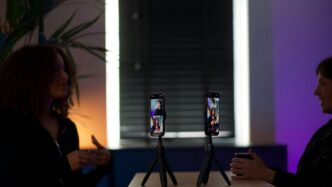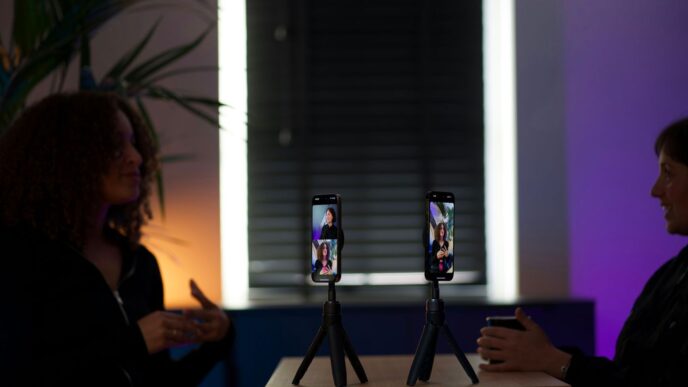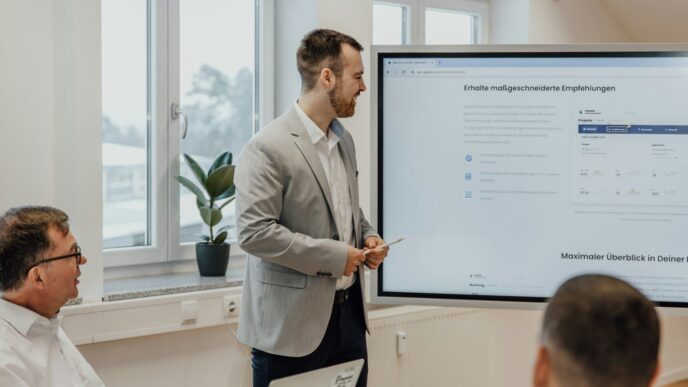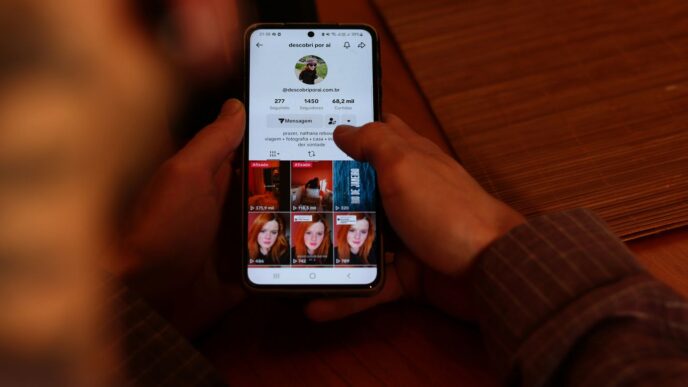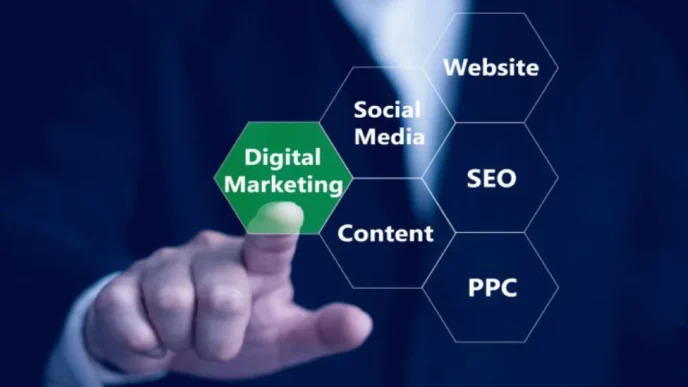Figuring out what makes your audience tick is pretty important if you want them to pay attention to what you’re putting out there. It’s not just about posting stuff and hoping for the best; you actually need to understand who you’re talking to. This means digging into who they are, what they like, and where they hang out online. When you get this right, you can make content that actually connects, and that’s the whole point, right? Let’s talk about how to get this done.
Key Takeaways
- Knowing your audience means looking at who they are, what they’re into, and where they spend their time online.
- Using data from analytics tools helps you see what’s working and what’s not with your audience.
- Creating content that people actually want to see and interact with is key to keeping them interested.
- Putting what you learn from data into action, like making your content easier to find, can really help keep people engaged.
- Paying attention to how your audience interacts, like comments and shares, helps you build stronger relationships and loyalty.
Understanding Your Audience for Effective Engagement
To really connect with people, you first need to know who they are. It sounds obvious, but it’s easy to skip this step when you’re eager to get your message out there. But honestly, if you don’t know who you’re talking to, your efforts are likely to miss the mark. Think about it: you wouldn’t try to sell snowshoes in Hawaii, right? The same applies to your content. Understanding your audience is the bedrock of any successful engagement strategy. It’s about more than just demographics; it’s about getting into their heads and understanding what makes them tick.
Identify Key Audience Characteristics
Start by figuring out the basics. Who are these people? What are their ages, where do they live, what kind of jobs do they have? This isn’t just busywork; this information helps paint a picture. For instance, knowing your audience is primarily young adults might mean you focus more on mobile-friendly content and platforms like TikTok or Instagram. If your audience is older, maybe Facebook or email newsletters are a better bet. It’s about meeting them where they are.
Research Target Audience Interests and Motivations
Once you have a general idea of who they are, dig a little deeper. What are they interested in? What problems are they trying to solve? What gets them excited? This is where you move beyond just knowing their age and location to understanding their needs and desires. Maybe they’re looking for quick tips to save time, or perhaps they’re passionate about environmental issues. Finding out what drives them helps you create content that actually matters to them. You can find this out through surveys, looking at comments on your existing content, or even just observing conversations happening online in relevant communities. It’s about figuring out what they care about.
Determine Preferred Content Channels
So, you know who they are and what they like. Now, where do they hang out online? Do they spend their time scrolling through Instagram, reading blog posts, watching YouTube videos, or listening to podcasts? Different groups prefer different platforms. Knowing their preferred channels is key to getting your content in front of the right eyes. If your audience loves video, you’ll want to invest more in creating video content. If they’re active on LinkedIn, focus your efforts there. It’s about putting your content where your audience is most likely to see and interact with it. You can check out analytics from your own website to see where your current visitors are coming from.
Leveraging Data for Smarter Engagement Decisions
Making good choices about how you connect with people really depends on knowing what they’re into and what they’re doing. It’s not just about guessing; it’s about looking at what the numbers tell you. When you pay attention to the data, you can figure out what’s working and what’s not, which helps you make better plans.
Identify Key Engagement Metrics
First off, you need to know what to measure. Not all numbers are created equal, so pick the ones that actually show if people are connecting with your stuff. Things like how long someone stays on a page, if they leave right away (that’s bounce rate), or if they do what you want them to do (like sign up or buy something) are pretty important. If lots of people leave your site as soon as they land, it’s a sign that maybe the page isn’t what they expected or isn’t interesting enough.
Utilize Analytics Tools for Behavior Tracking
There are plenty of tools out there that can help you see what people are doing on your site or with your content. Think of Google Analytics, or maybe Hotjar. These tools give you a look at things like which pages get the most views, how much time people spend reading or watching, and the path they take through your site. It’s like having a map of your audience’s journey, showing you where they might be getting stuck or losing interest.
Analyze Engagement Patterns and Trends
Once you’re collecting data, you have to actually look at it to find patterns. For example, maybe you notice that people really click on your video content more than your written articles. That’s a pretty clear sign that you should probably make more videos. Or perhaps a certain topic gets way more comments and shares. That tells you what your audience is talking about and what they want to discuss further. It’s about spotting these trends so you can adjust what you’re doing.
Here’s a quick look at some common metrics and what they might mean:
| Metric | What it Shows |
|---|---|
| Time on Page | How long people spend with your content |
| Bounce Rate | Percentage of visitors who leave after viewing only one page |
| Click-Through Rate (CTR) | Percentage of people who click on a link or call to action |
| Social Shares | How often your content is shared on social media |
| Comments | How many people are talking about your content |
By keeping an eye on these, you get a clearer picture of how people are interacting with what you put out there.
Crafting Content That Resonates
So, you’ve figured out who you’re talking to and where they hang out online. Now comes the fun part: making stuff they actually want to see. It’s not just about putting out any content; it’s about making content that makes people stop scrolling and pay attention. Think about it like this: you wouldn’t serve plain rice at a fancy dinner, right? Same idea here.
Create Engaging and Valuable Content
This is where you really show your audience you get them. What are their problems? What makes them laugh? What do they need help with? Your content should answer these questions. It needs to be more than just a sales pitch; it should offer real help or entertainment. People are busy, and they won’t spend time on content that doesn’t give them something back. Try mixing things up. Use stories, maybe some cool graphics, or even short videos. Just make sure it feels fresh and relevant to what’s happening now. For example, if you’re in the cooking niche, instead of just posting a recipe, maybe share a quick video of a common mistake people make when cooking that dish and how to fix it. That’s the kind of helpful stuff that gets noticed.
A/B Test Content Formats for Optimal Performance
Not sure if your audience prefers a quick tip graphic or a short explainer video? Test it! A/B testing is basically trying out two different versions of something to see which one does better. You could post a tip as a graphic on Monday and then as a short text post on Tuesday, and see which one gets more likes or comments. Or, try different headlines for the same article. It’s a simple way to figure out what works best without just guessing. You might be surprised by what performs well. For instance, we found that our audience really liked short, actionable lists, so we started breaking down longer articles into digestible posts like that. It’s all about seeing what clicks.
Tailor Content to Audience Segments
Remember those audience characteristics you identified earlier? Now you use them. If you have a group of customers who are beginners and another group who are experts, you don’t want to send them the same content. Beginners might need basic guides, while experts might want advanced tips or industry news. Segmenting your audience and creating content specifically for each group shows you’re paying attention and makes your message much more effective. It’s like talking to each friend individually about something they care about, rather than shouting one thing to a whole crowd. This personal touch makes a big difference in how people connect with your brand.
Implementing Data-Driven Engagement Tactics
So, you’ve got your data, you know what your audience likes, and now it’s time to actually do something with that information. This is where we put the ‘data-driven’ part into practice. It’s not just about looking at numbers; it’s about using them to make your content work harder for you.
First off, let’s talk about making sure people can actually find your stuff. If your content is buried so deep that no one stumbles upon it, it doesn’t matter how good it is. We need to think about search engines. What words are people typing into Google when they’re looking for something like what you offer? Using tools to figure out those keywords and then naturally weaving them into your articles, titles, and descriptions is a big help. It’s like putting up a clear signpost for your audience.
Then there’s the whole idea of bringing people back who might have wandered off. Think about it: someone visited your site, maybe read an article, but then didn’t come back for a while. What can we do? We can use what we know about them – like what they read before – to send them a nudge. Maybe it’s an email with a similar article, or a notification about something new they might like. It’s about being helpful and reminding them why they came to you in the first place. The key here is to be relevant, not annoying.
Finally, this isn’t a ‘set it and forget it’ kind of deal. The digital world changes fast, and so does your audience. What worked last month might not work next month. So, you’ve got to keep an eye on your numbers. Are people clicking? Are they staying on the page? Are they doing what you hoped they would? Based on what the data tells you, you need to be ready to tweak things. Maybe a certain type of headline isn’t getting clicks anymore, or a particular topic isn’t holding attention. Adjusting your approach based on this feedback loop is how you keep getting better and keep your audience engaged.
Deepening Connections Through Interaction

It’s not enough to just put content out there and hope people notice. You really need to get people talking and interacting with what you’re sharing. This is where building real connections comes into play.
Foster Dialogue with Comments and Replies
Comments sections on blog posts or social media can be goldmines. When people leave comments, it means they’re thinking about your content and want to share their thoughts. The trick is to actually respond. A simple reply can make someone feel heard and encourage them to comment again. It shows you’re paying attention and that you care about what they have to say. Think of it as a conversation, not just a broadcast.
- Acknowledge every comment, even if it’s just a quick "Thanks for sharing!".
- Ask follow-up questions to keep the conversation going.
- Address any concerns or questions directly and helpfully.
Encourage Shares and Reshares of Content
When someone shares your content, it’s like they’re vouching for you to their own network. That’s pretty powerful stuff. Make it easy for them to share by including clear share buttons. Also, create content that’s genuinely shareable – maybe it’s a helpful tip, a funny observation, or something that sparks a strong opinion. People share things that make them look good or that they think their friends will appreciate.
Drive Website Interaction Through Links
Your website is often the central hub for everything you do. Using links within your content to guide people back to your site is a smart move. Whether it’s linking to a related blog post, a product page, or a sign-up form, these links give people a clear next step. Make sure the links are relevant and lead to content that offers more value. We found that including links to specific resources can really help people who are looking for support on specific topics.
Here’s a quick look at how different types of interactions can add up:
| Interaction Type | Example | Impact |
|---|---|---|
| Comments | User asks a question on a blog post | Builds community, provides feedback |
| Shares | User shares an infographic on LinkedIn | Increases reach, social proof |
| Link Clicks | User clicks a link to a case study | Drives traffic, indicates interest |
Measuring Success in Audience Analysis
So, you’ve put in the work to create content and get it out there. That’s great! But how do you know if it’s actually working? Measuring success in audience analysis isn’t just about counting likes; it’s about understanding what those numbers mean for your overall goals.
You need to track the right things to see what’s connecting and what’s falling flat. It’s easy to get lost in all the data, but focusing on key indicators will give you a clearer picture.
Here are some common metrics you’ll want to keep an eye on:
- Likes, Comments, and Shares: These are the most basic signs of interaction. A lot of likes might mean people agree or appreciate the content. Comments show a deeper level of engagement, where people are willing to share their thoughts. Shares are fantastic because they mean your audience finds the content so good they want to spread it to their own networks.
- Video Views and Completion Rates: For video content, just getting views isn’t enough. You need to know if people are actually watching. A high completion rate means your video is holding attention. If people drop off early, you might need to rethink your video’s pacing or message.
- Click-Through Rates (CTR) and Time on Page: These are super important for understanding how your content drives action. CTR tells you how many people clicked a link in your content, showing interest in learning more. Time on page, especially on your website, indicates if people are actually reading or engaging with what you’ve published. A short time on page might mean the content isn’t what they expected or isn’t holding their interest.
Think of these metrics like a report card for your content. They tell you what’s working well and where you might need to make some adjustments. It’s not about perfection, but about continuous improvement based on what your audience tells you through their actions.
Building Brand Loyalty Through Engagement
When people really connect with what you’re putting out there, they tend to stick around. It’s like they feel you get them, and that’s a big deal for keeping them interested long-term. They start to understand what your brand is all about, its goals, and its core beliefs, and if that matches up with their own values, their connection gets even stronger. This makes them more likely to become loyal customers.
Enhance Audience Insights with Interaction Data
Paying attention to how people interact with your content gives you a clearer picture of what they’re thinking. You can ask them directly about their challenges or what they’re looking for. By watching their comments, shares, and replies, you learn a lot about what they like, what problems they have, and what they expect. This information helps you make your products and marketing better, so they fit what your audience actually needs.
Strengthen Social Proof with Engaged Customers
Customers who are really involved often become your biggest fans. When they talk about your brand, share good experiences, and recommend you, it builds trust for others. People tend to believe what their peers say more than ads. So, your engaged customers basically act like a free marketing team, making your brand seem more reliable.
Improve User Experience with Tailored Content
Your audience’s engagement tells you what kind of content works best. By looking at what gets the most likes, comments, and shares, you can adjust your content plan to give them more of what they want. This keeps your content fresh and relevant, and helps you stay ahead of what’s popular.
Wrapping It Up: Keep the Conversation Going
So, we’ve talked about a lot of ways to get people to pay attention to your brand and what you’re putting out there. It’s not just about posting stuff and hoping for the best. You really need to know who you’re talking to, what they like, and where they hang out online. By paying attention to how people react – what they click on, what they comment about, what they share – you get a clearer picture. This information helps you make better content and connect more directly with your audience. Remember, it’s an ongoing thing. Keep trying different approaches, see what works, and adjust as you go. Building that connection is key to keeping people interested and turning them into loyal fans.
Frequently Asked Questions
What exactly is audience engagement?
Think of audience engagement as how much people interact with your brand or what you share. It’s like when someone likes a post, leaves a comment, or shares something with their friends. When people engage, it means they find what you’re doing interesting and valuable.
Why is it important to understand my audience?
Knowing who you’re talking to is super important! You need to figure out what your audience likes, what they’re interested in, and where they hang out online. This helps you create content that they’ll actually want to see and interact with.
How can I track if my audience is engaging?
You can use tools like Google Analytics or social media insights to see what people are doing. Look at things like how many people click your links, how long they stay on your page, or if they comment and share. This data tells you what’s working and what’s not.
How do I create content that people will like?
Make content that’s fun, helpful, or interesting! Ask questions, tell stories, or use cool pictures and videos. You can also try different types of content, like blog posts versus videos, to see which ones your audience likes best.
How can I encourage more interaction with my audience?
It’s all about talking back! When people comment, try to reply to them. If they share your stuff, thank them! This shows you care and makes them feel more connected to your brand.
Does audience engagement help build customer loyalty?
Yes! When your audience engages with you, they start to trust you more and are more likely to become loyal customers. It’s like building a friendship – the more you connect, the stronger the bond becomes.



